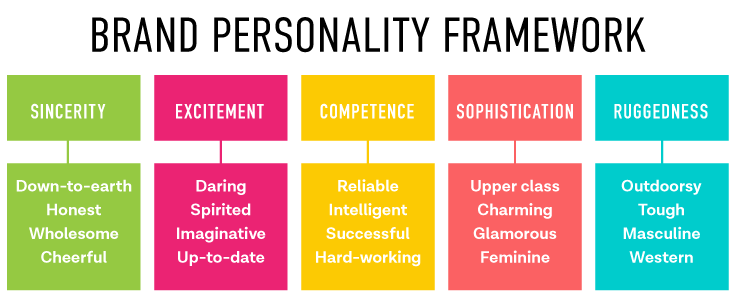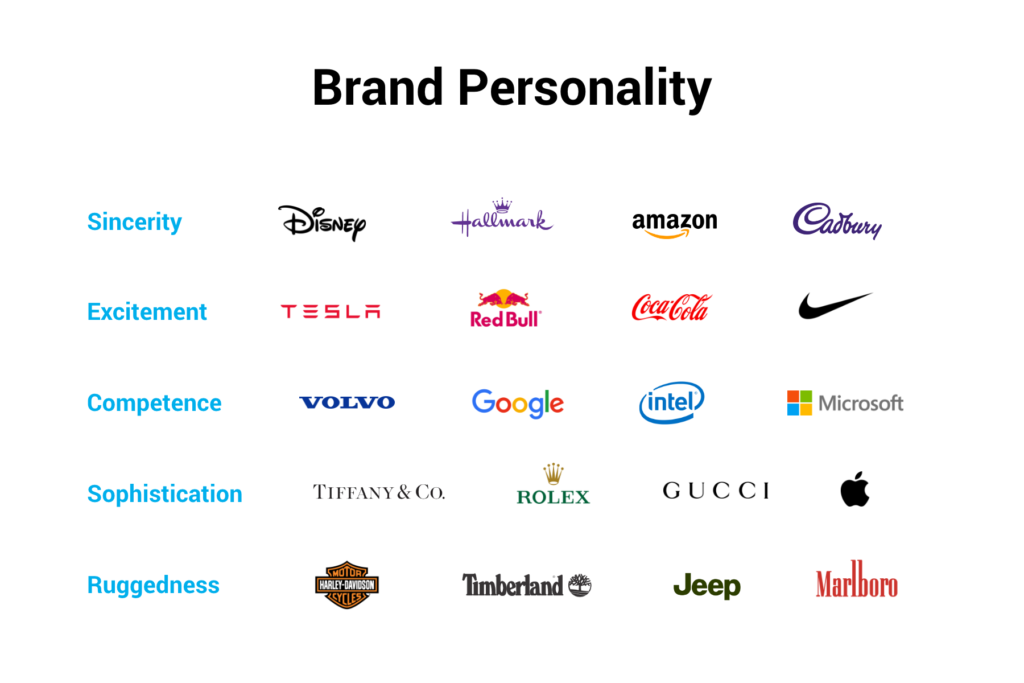Have you ever thought about how the brands you purchase from are a reflection of you are or, at least, how you want to be perceived? Does wearing lip gloss from Glossier make you feel more chic and trendy? Does wearing Nike clothing make you feel more sophisticated and athletic?
Let’s take a deeper look into why brand personality is important for marketers to take into consideration when growing consumer loyalty and engagement.

The concept of brand personality is most often defined as a brand having a unique set of human resembling characteristics and persona (Aaker, 1997; Freling, et al., 2011). Brand personality is what drives consumers to view brands as if they were human by pairing it with a recognizable visual aesthetic and distinctive voice.
The most notable study on brand personality was conducted by Jennifer Aaker in 1997. In the research Aaker (1997) categorized and summarized brand personality into five different human personality traits including sincerity, excitement, competence, sophistication, and ruggedness.
How does this relate to consumers? Well, people like people who they’re like or want to be like — the same is true with brands. We love brands that have similar characteristics to ours, or one that we aspire to have.

Over the years, organizations and management have acknowledged the pivotal role brand personality has on consumer loyalty and engagement (Freling, et al., 2011). Consumers use brand personality to identify and assess if a brand fits their own personality, be it their actual or intended personality (Huang, & Mitchell, 2014). By creating a brand personality that closely mirrors a consumer’s personality, organizations are able to attract their audiences to become emotionally attached and loyal to the brand.
People like to share and be associated with things that make them look good, smart, and/or hip.
There is a belief that if consumers use products or have relations with an appealing brand then they will perceive themselves to have the same persona or personality of that brand. Consumers often pick and choose the brands they interact with as a way to incorporate the brand’s personality to their own sense of self (Gao, Wheeler, & Shiv, 2008). In other words, people can prefer to use and relate to certain brands as a way of affirmation or enhancement to their own self-image.
For example, brands can often have certain traits associated with their brand image or personality like how Calvin Klein may be associated with “upper-class” or Abercrombie may be associated with “arrogance” (Trabold & Mathur, 2011). How a person wants to be perceived, could affect how they engage with a brand based on the personality a brand showcases.
Brand personality does not always have to an extension of how a person wants to be perceived but instead, consumers can also have relations with a brand to possibly get the same traits to be tied to them. For example, a person may not be masculine or want to be perceived as masculine but if they use or have relations with a brand like Harley-Davidson motorcycles, then maybe image will be correlated to them (Aaker, 1997; Gandara & Hellgren, 2011).
So the next time you pick up an item at Target, think about what does that item says about you? Better yet, take brand personality into consideration when you write copy for your company. Who are you trying to connect with?
References
Aaker, J. (1997). Dimensions of brand personality. Journal of Marketing Research, 34(3), 347–356. https://doi.org/10.1177/002224379703400304
Dvornechuck, A. (2019). Brand personality: Traits of top brands. Retrieved from https://medium.com/@ebaqdesign/brand-personality-traits-of-top-brands-19c58890770f
Gandara Gil, A., & Hellgren, D. (2011). Brand Personality: Impact on Brand Trust and Consumer Preferences: A comparative study of Germany and Sweden.
Gao, L., Wheeler, S., & Shiv, B. (2009). The “Shaken Self”: Product Choices as a Means of Restoring Self‐View Confidence. Journal of Consumer Research, 36(1), 29–38. https://doi.org/10.1086/596028
Freling, T., Crosno, J., & Henard, D. (2011). Brand personality appeal: conceptualization and empirical validation. Journal of the Academy of Marketing Science, 39(3), 392–406. https://doi.org/10.1007/s11747-010-0208-3
Huang, H., & Mitchell, V. (2014). The Role of Imagination and Brand Personification in Brand Relationships. Psychology & Marketing, 31(1), 38–47. https://doi.org/10.1002/mar.20673
Trabold, L., & Mathur, P. (2011). Is Abercrombie Making Me Arrogant? the Impact of Brand Personality Traits on Post-Consumption Behavior. Advances in Consumer Research, 38. Retrieved from http://search.proquest.com/docview/1808605137/
References:

8 Responses to You are What You Wear: How Brand Personality Impacts How Consumers See Themselves